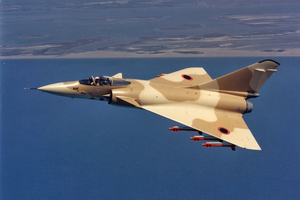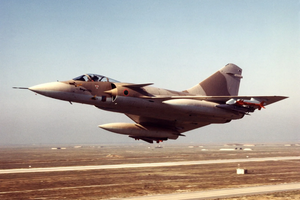NA48 Chainbreaker: Difference between revisions
mNo edit summary |
mNo edit summary |
||
| Line 17: | Line 17: | ||
|more users= <!-- Limit is three (3) in 'more users' field, three (3) total users with primary user. Please separate with <br />. --> | |more users= <!-- Limit is three (3) in 'more users' field, three (3) total users with primary user. Please separate with <br />. --> | ||
|produced= 1998–present | |produced= 1998–present | ||
|program cost= $ | |program cost= Ⲇ17 billion ($22 billion FY2018) | ||
|unit cost= $70 million | |unit cost= Ⲇ54 million ($70 million FY2022) | ||
|number built= 182 | |number built= 182 | ||
|developed from= {{wp|Mirage 2000|NA28 Spirit Wind}} | |developed from= {{wp|Mirage 2000|NA28 Spirit Wind}} | ||
Revision as of 02:30, 15 November 2022
This article is incomplete because it is pending further input from participants, or it is a work-in-progress by one author. Please comment on this article's talk page to share your input, comments and questions. Note: To contribute to this article, you may need to seek help from the author(s) of this page. |
| NA48 Chainbreaker | |
|---|---|

| |
| Role | Multirole combat aircraft |
| National origin | Talahara |
| Manufacturer | United Aeronautics Syndicate |
| First flight | 9 March 1998 |
| Introduction | 18 May 2004 |
| Status | In service |
| Primary user | Talaharan Air Corps |
| Produced | 1998–present |
| Number built | 182 |
| Program cost | Ⲇ17 billion ($22 billion FY2018) |
| Unit cost |
Ⲇ54 million ($70 million FY2022)
|
| Developed from | NA28 Spirit Wind |
The NA48 Chainbreaker (Takelat: ⵏⴰ48 ⵔⴰⵣⴰⵜⵉⵙⵦⵏⵙⴰⵍⴰⵏ; NA48 Razatisensalan) is a twinjet, canard, delta-wing, multirole combat fighter manufactured by the United Aeronautics Syndicate. The Chainbreaker is generally classified as a 4.5++ generation aircraft, and occasionally as a heavy multirole fighter. It is equipped with advanced sensors and avionics with limited stealth design and is capable of engaging in supremacy, interdiction, reconnaissance, close air support, and anti-ship warfare missions.
Developed from the NA28 Spirit Wind, the Chainbreaker was intended to consolidate the roles of the NA28 Spirit Wind and the NA28/36 Sunray in a modern platform. The airframe first flew in 1998, but the development of the aircraft's systems delayed its official introduction to 2004. While primarily a domestic project, the full avionics and sensor suite was developed with a number of foreign resources and technologies.
Following its introduction, the Chainbreaker was marketed for export to a limited number of socialist republics worldwide. The Talaharan Air Corps remains the primary user of the aircraft, in addition to the Tyreseian Workers' Naval Air Service.
Development
The NA48 Chainbreaker was developed from the single-engine NA28 Spirit Wind and shares a considerable number of commonalities with the older aircraft. Despite this, the Chainbreaker is considerably larger and heavier than its predecessors. The design of the airframe was completed in the mid-1990s and production began in 1997. The first test flight took place in May of 1998. After its success, full production of the airframes was commenced that year, though the aircraft was only officially brought into service after the sensors and avionics were successfully selected and installed in 2004.
Origin
After the introduction of the NA28/36 Sunray in 1986, the Talaharan Air Corps relied on three different mainline fighter aircraft, including both variants of the NA28 and the aged NA6 Tiara which had originally entered into service in 1961. By 1990, the Talaharan Air Corps was preparing for the retirement of the Tiara and were seeking to adopt a new modern fighter aircraft with superior multi-mission capabilities and at least some limited stealth design elements for the new millennium.
The United Aeronautics Syndicate received its commission for the project, dubbed the "X50 Fighter Program", later that year from the TCDF Air Corps Logistics and Design Commissariat and an internal tendering process within the Syndicates design bureau was commenced following Tyreseian endorsement under the Rubric Coast Joint Development Agreement. Reportedly, four designs were evaluated, including wind tunnel testing, at a scale model phase. However, only one design made it to the full prototyping stage to be presented to the Logistics and Design Commissariat in 1997. This prototype from Design Bureau B - Weskera ultimately underwent multiple revisions before first taking flight a year later. The X50 would subsequently be renamed the X48BW after the year of its first flight and entered into full production as the NA48 Chainbreaker.
Production
While the United Aeronautics Syndicate began full-scale production of the airframe immediately after receiving approval from the Logistics and Design Commissariat, the delivery of the planned avionics and sensor suite of the final aircraft was initially delayed owing to the number of parts of devices that had to be sourced from Tsurushima and Wazheganon. As such, the production chain for the aircraft was only finalized in 2003, with the Chainbreaker officially entering into active service with the Talaharan Air Corps in 2004.
Production of the airframes is handled primarily at the United Aeronautics Syndicate Manufactory in Wasif. The avionics suite is assembled domestically at the port of Mutafayil, with a number of components still produced overseas. The avionics suite is subsequently shipped for final installation in Wasif.
Design
The NA48 Chainbreaker is a is a twinjet, delta-wing aircraft with canards to reduce the load on the main wings and to increase the aircraft's maneuverability. The aircraft is ostensibly an upscaled version of the older NA28 Spirit Wind multirole fighter. While the Spirit Wind was powered by a single ZH'N N23Ch11 GAN engine, the Chainbreaker features two of the same engine. The Chainbreaker's wing surface area is approximately 80% greater than the Spirit Wind and the mass of the airframe is approximately 40% greater as well. The ordnance capacity of the newer aircraft is also approximately 50% greater than its elder.
While its general appearance, profile, and ergonomics resemble the Spirit Wind, it has a number of major distinctions. The two most evident differences are the twin-engine configuration and the canards at the fore of the aircraft. These upgrades afford the Chainbreaker significant improvements to speed and manoeuverability despite the increased weight and size of the aircraft. At its inception, the Chainbreaker also had significantly more advanced avionics, though the NA28 fighters have both since been upgraded to a modern standard. Another upgrade over the previous aircraft is the bubble canopy which affords the pilot a greater field of view. Overall, improvements to the airframe allow it to operate consistent at Mach 2.2 and at an altitude of 20 km.
Engines
The ZH'N N23Ch11 GAN is a single shaft turbofan turbojet engine. The engine was originally developed for the NA28 Spirit Wind fighter which equipped a single powerplant. The NA48 Chainbreaker mounts two of the engines in a twin configuration, offering it a significant power improvement. The engine was designed to be capable of reaching Mach 2.5 in a test aircraft. The engine first took flight in 1973 and first went supersonic the next year.
The engine is a single-shaft design, with eight compressor stages. The first three compressor stages were enlargened to permit both high-pressure and low-pressure airflow through the same shaft. The turbine is a two-stage axial design with a low-pressure annular combustor. The principles that guided the design and production of the engine were simplicity and cost-efficiency along with a major performance increase over existing Talaharan engines.
Equipment and sensors
Armament
The NA48 Chainbreaker has the same gun configuration as the NA28 Spirit Wind, with dual 30×150mm seven-chamber revolver autocannons, each loaded with 125 rounds. The autocannons have three firing modes: continuous fire, 0.5-second burst fire, or 1-second burst fire. The rate of fire can also be changed between air-to-ground modes (300 or 600 rounds per minute) and air-to-air modes (1,500 or 2,500 rounds per minute). In continuous mode at the maximum rate of fire, the aircraft's ammunition reserves can be depleted in 6 seconds.
Operators
Specifications
General characteristics
- Crew: One
- Length: 18.7 m (61 ft 4 in)
- Wingspan: 12 m (39 ft 4 in)
- Height: 5.8 m (19 ft 0 in)
- Wing area: 73 m2 (790 sq ft)
- Empty weight: 10,600 kg (23,369 lb)
- Gross weight: 20,100 kg (44,313 lb)
- Max takeoff weight: 24,500 kg (54,013 lb)
- Fuel capacity: approx 11,000 l (2,900 US gal; 2,400 imp gal) internal fuel
- Powerplant: 2 × ZH'N N23Ch11 GAN afterburning turbofan engines, 64.3 kN (14,500 lbf) thrust each dry, 95.1 kN (21,400 lbf) with afterburner
Performance
- Maximum speed: 2,445 km/h (1,519 mph; 1,320 kn) max level speed
- Maximum speed: Mach 2.3
- Maximum sustained speed: Mach 2.2
- Approach speed: 260 km/h (160 mph; 140 kn)
- Range: 2,000 km (1,243 mi; 1,080 nmi)
- Combat range: 1,850 km (1,150 mi; 999 nmi) plus, with external tanks and recce pod
- Service ceiling: 20,000 m (66,000 ft)
- Rate of climb: 305 m/s (60,000 ft/min)
- Time to altitude: 15,000 m (49,213 ft) (M2) 3 minutes
- Wing loading: 220 kg/m2 (45 lb/sq ft) at combat weight
Armament
- Guns: 2 × 30 mm autocannons with 250 rounds of ammunition
- Hardpoints: 13 with a capacity of 9,500 kg (20,900 lb),with provisions to carry combinations of:
- Rockets: up to 4 x 18 rocket pods
- Missiles:
- Air-to-air
- 0T1 Wasp air-to-air missile
- Air-to-surface
- 24T1 Sunburst air-to-ground missile
- AM39T2 Shipbreaker anti-ship missile
- ET0 Black Sky cruise missile
- 30T0 Falcon MCLOS missile
- 50T0 Sabre precision-guided munition
- Air-to-air
- Other:
- up to 3 x 2,500 l (660 US gal; 550 imp gal) drop tanks
- FLIR pod
- Recce pod
- laser designator pod
- Bombs: up to 27 x 250 kg (551 lb) bombs
Avionics
- XW97T2 Sentinel AESA radar
- XT10 Guardian electronic warfare suite
- XT99 Shibainu tracking system
See also
Aircraft of comparable role, configuration, and era


